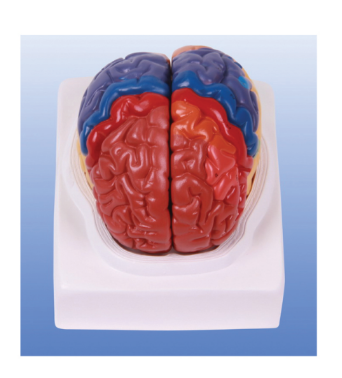Homepageпјҡ NEWS >> How does the model mimic the real structure of the cerebral cortex?
When simulating the real structure of the cerebral cortex, the cerebral cortex partition model adopts various methods and means to present its complexity and delicacy as accurately as possible. Here are some key points on how to simulate the real structure of the cerebral cortex:

1. Use of color and marking
Cortical zoning models often use different colors or markers to distinguish between different lobes and specific functional areas. For example, the frontal, parietal, temporal, and occipital lobes may be represented in different colors for quick identification. At the same time, some specific functional areas, such as the motor language center (Broca's area) and the auditory language center (Wilnick's area), may also have special markers or labels.
2. Simulation of trench structure
The surface of the cerebral cortex is highly extended and curled, forming many furrows and cracks. To simulate this complex trench structure, the model may have an uneven surface design with grooves and bumps in place to represent real trenches and cracks. This design not only brings the model closer to the real cerebral cortex in appearance, but also helps to understand the relative positions and connections between different regions.
3. Size and proportion considerations
The actual size and proportions of the cerebral cortex in the human body need to be taken into account when making models of cerebral cortex partitions. In general, the model is scaled down to make it easier to display and carry. However, this narrowing does not affect the accuracy of the model in demonstrating the structure and function of the cerebral cortex.
4. Division of functional areas
Different areas of the cerebral cortex are responsible for different functions. In order to more accurately simulate the location and scope of these functional areas, the model may include markers or labels in specific areas, accompanied by corresponding text descriptions. This helps users more quickly find the functional area of interest and understand its related functions.
5. Possibility of dynamic simulation
While most models of cerebral cortex partitions are static, some advanced models may employ dynamic simulation techniques to demonstrate dynamic changes in the cerebral cortex. For example, through LED lights or other indicators to show the active status of different areas or changes in the connection mode. This dynamic simulation can more vividly demonstrate the functional and structural characteristics of the cerebral cortex.
In summary, the cerebral cortex partitioning model simulates the real structure of the cerebral cortex through various methods and means. These models are not only highly accurate and practical, but also contribute to a deeper understanding of the structural and functional features of the cerebral cortex.